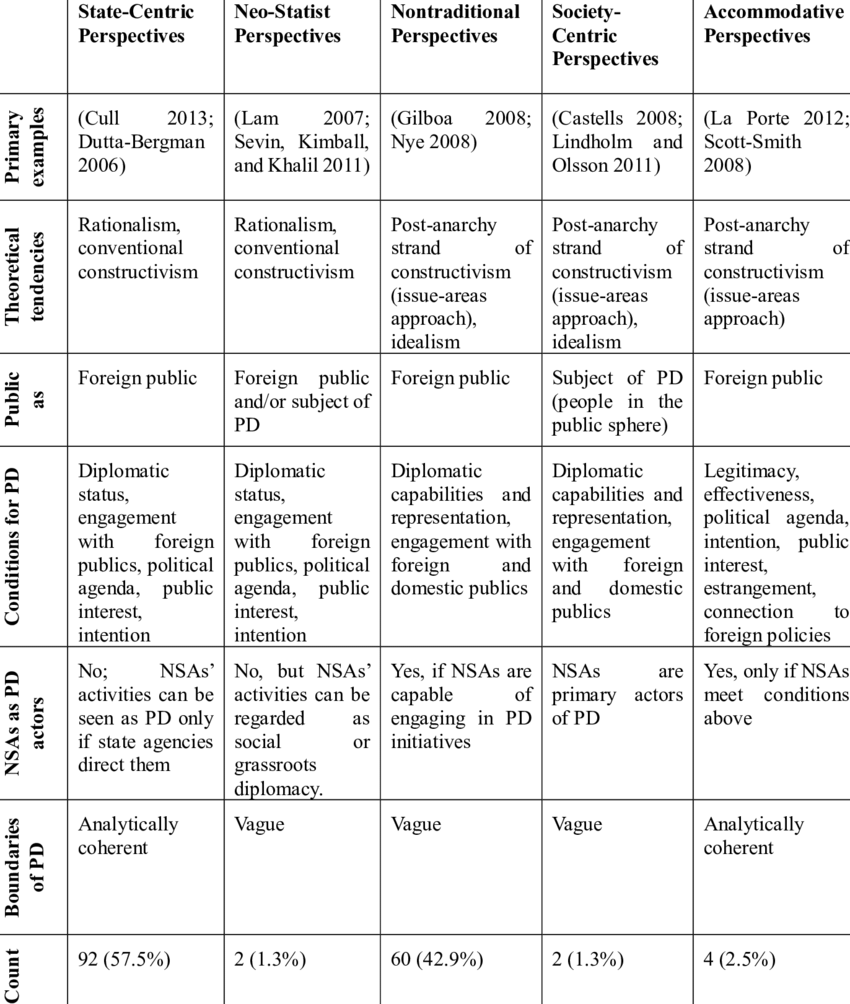Taxonomy of Public Diplomacy Perspectives
Source publication


The Boundaries of Public Diplomacy and Nonstate Actors: A Taxonomy of PerspectivesArticleFull-text available
- Jan 2019
Public diplomacy (PD) lacks an agreed-upon definition and boundaries. The ambiguity surrounding the conceptualization of the term leads to confusion among scholars and practitioners and hinders the consolidation of PD as an academic field. This article surveys 160 articles and books on PD, categorizes diverse perspectives into a taxonomy, and explo…
View
Citations
… Following the September 11 attacks, “new public diplomacy” (Melissen, 2005;Seib, 2009;Snow, 2009) was introduced in order to move away from the one-way communication of old public diplomacy and toward two-way symmetrical communication practices. New public diplomacy paved the way for the expansion of the field in general, with 96 percent of the 185 most-cited, SCOPUS- indexed articles on public diplomacy being written after September 11 (Ayhan, 2019). …Editorial: Special Issue on Soft Power and Public Diplomacy in East AsiaArticleFull-text available
- Aug 2018
- J CONTEMP ASIA
Editorial for Special Issue: Soft Power and Public Diplomacy in East Asia
ViewBranding Korea as ‘My Friend’s Country’ The Case of VANK’s Cyber Public DiplomatsPreprintFull-text available
- Apr 2018
- KOREA OBS
The role of non-state actors in public diplomacy remains an unsettled question in the literature. However, various transnational activities of non-state actors are often called public diplomacy, without discrimination. The lack of empirical studies on non-state public diplomacy is to blame for this conceptual confusion. Analytical and empirical studies of non-state public diplomacy are needed to consolidate this phenomenon, which is relatively new, while maintaining the conceptual clarity of public diplomacy. This study explores how Voluntary Agency Network of Korea (VANK), a Korean NGO, conducts public diplomacy and nation branding of Korea based on its members’ relationships with foreigners. To gain an in-depth understanding of VANK’s activities from the perspectives of public diplomacy and nation branding, this study follows an exploratory single case study method. The findings of this article suggest how VANK and similar non-state actors offer potential for public diplomacy and nation branding that can be utilized also by state agencies.
ViewIntangible Cultural Heritage: Is it a Platform for Cooperation or Competition between Cultural Diplomacies? The Case of South Korea – Japan – China Relations within UNESCO’s ICH FrameworkArticleFull-text available
- Oct 2018
Scholars from international relations, communication and other related fields discuss the importance and place of Cultural Diplomacy (CD) as a foreign affairs tool. CD is a domain that has been explored by few scholars so far. Not much attention was dedicated to the Intangible Cultural Heritage (ICH) list, that was initiated by the United Nations Educational, Scientific and Cultural Organization (UNESCO). In this framework CD is actively applied and practiced. This paper explores the case of relations among China, Japan, and South Korea as state parties of the Convention on ICH initialized by UNESCO in 2003. The given case study examines CD of the three countries as ICH state parties in terms of the three main areas of their activities: the nomination and inscription of the intangible heritage; the development of ICH in the region and worldwide through providing facilities; and financial assistance to the ICH Fund. The analysis demonstrates that all three selected countries demonstrate collaborative and competitive CD. At the multilateral level, the selected countries conduct cooperative diplomacy while at the bilateral level, countries tend to apply competitive diplomacy. I conclude that the existing ICH legal and procedural framework, as well as the misperception of the values and aims of ICH by the state parties’ governing bodies encourage countries to cooperate and compete. The study is useful as a demonstration of how an international structure like UNESCO’s ICH that pursues good governance and universal values can turn into a battlefield for political competition among the most active member states. The author suggests changes in the legal framework of ICH to encourage non-state actors’ participation and cooperation among the selected countries.
ViewIntangible Cultural Heritage: Is it a Platform for Cooperation or Competition between Cultural Diplomacies? The Case of South Korea-Japan-China relations within UNESCO’s ICH FrameworkArticleFull-text available
- Oct 2018
Scholars from international relations, communication and other related fields discuss the importance and place of Cultural Diplomacy (CD) as a foreign affairs tool. CD is a domain that has been explored by few scholars so far. Not much attention was dedicated to the Intangible Cultural Heritage (ICH) list, that was initiated by the United Nations Educational, Scientific and Cultural Organization (UNESCO). In this framework CD is actively applied and practiced. This paper explores the case of relations among China, Japan, and South Korea as state parties of the Convention on ICH initialized by UNESCO in 2003. The given case study examines CD of the three countries as ICH state parties in terms of the three main areas of their activities: the nomination and inscription of the intangible heritage; the development of ICH in the region and worldwide through providing facilities; and financial assistance to the ICH Fund. The analysis demonstrates that all three selected countries demonstrate collaborative and competitive CD. At the multilateral level, the selected countries conduct cooperative diplomacy while at the bilateral level, countries tend to apply competitive diplomacy. I conclude that the existing ICH legal and procedural framework, as well as the misperception of the values and aims of ICH by the state parties’ governing bodies encourage countries to cooperate and compete. The study is useful as a demonstration of how an international structure like UNESCO’s ICH that pursues good governance and universal values can turn into a battlefield for political competition among the most active member states. The author suggests changes in the legal framework of ICH to encourage non-state actors’ participation and cooperation among the selected countries.
ViewTransnational non-state actors as “alt agents” of public diplomacy: Putin’s Russia versus Open RussiaArticle
- May 2019
This paper argues that non-state actors (NSAs) that challenge their respective states can claim a stake in their country’s public diplomacy by introducing and promoting narratives that (a) disrupt the official state-supported narratives and (b) present a more complex picture of their country-of-origin to the foreign publics. To conceptualize this type of engagement with foreign audiences, this project proposes the term “alternative agents” or “alt agents” of non-state public diplomacy. The paper combines Kelley’s (Agency change: diplomatic action beyond the state, Owman & Littlefield, London, 2014) framework of diplomatic capabilities of NSAs with Miskimmon et al. (Strategic narratives: communication power and the new world order, Routledge, New York, 2014) concept of strategic narratives to develop the definition of alt agents of public diplomacy. Using the case study of the transnational movement Open Russia, the paper illustrates how the work of alt agents aimed at connecting with foreign constituencies in order to achieve their political goals might look like in practice. The paper contributes to the scholarship on non-state public diplomacy by engaging with the relatively unexplored question of the role of adversarial non-state actors in public diplomacy, and the dynamic of their engagement with foreign stakeholders.
ViewOriginal Article



 Kadir Jun Ayhan
Kadir Jun Ayhan Eriks Varpahovskis
Eriks Varpahovskis









